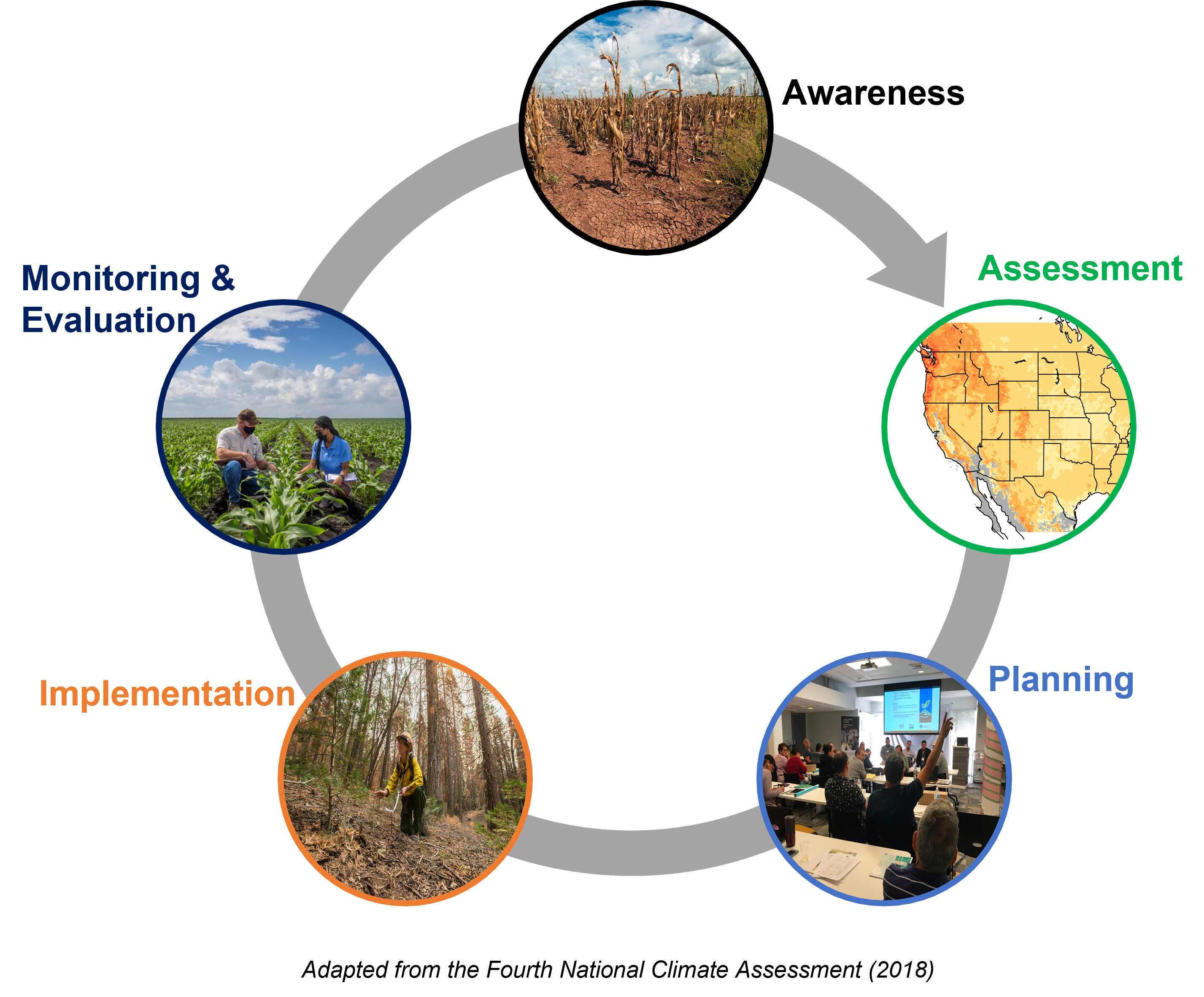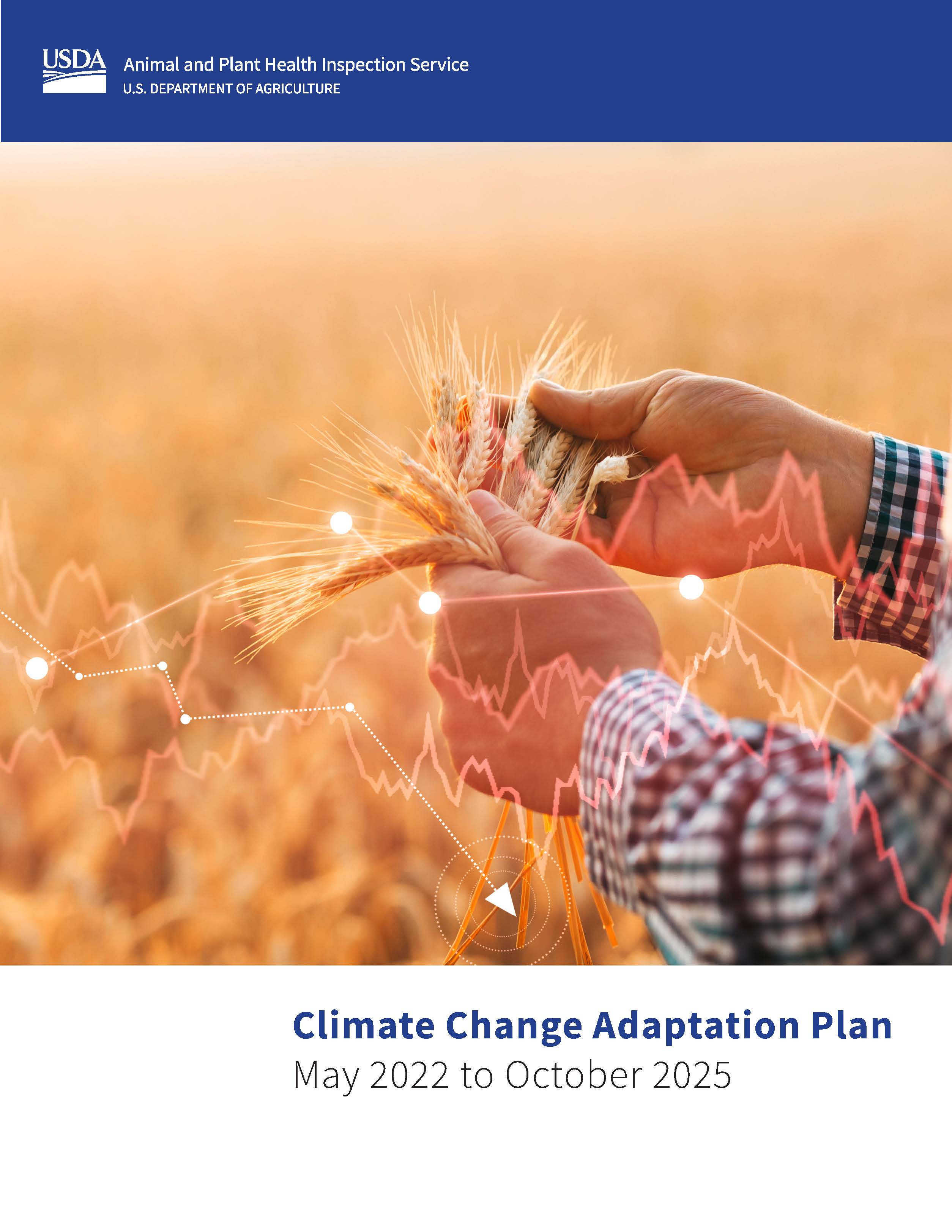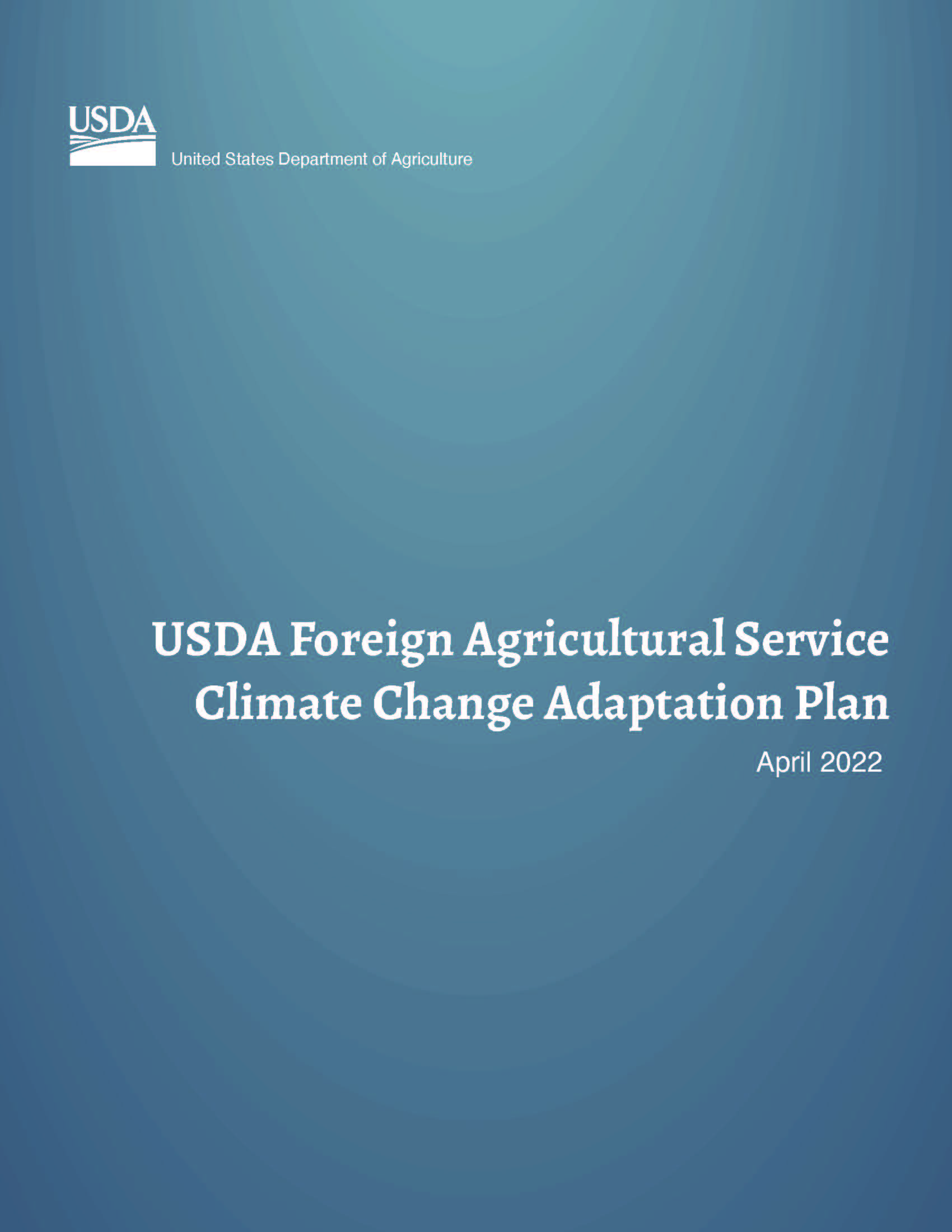Climate Change Adaptation

On This Page:
- USDA Action Plan for Climate Adaptation and Resilience and New 2022 Progress Report
- Climate Adaptation across USDA
- Adaptation in Action with USDA’s Climate Hubs
The effects of climate change on agriculture, forests, and rural communities are complex and far-reaching. Already, producers and land managers across the country are experiencing these impacts in the form of shifting weather patterns and increasingly intense extreme events like floods and wildfire.

To address the impacts of climate change on USDA’s mission delivery and to meet stakeholder needs in a changing climate, the Office of Energy and Environmental Policy (OEEP) works across USDA to ensure that the effects of climate change on working lands and rural communities are understood, and that climate adaptation is integrated into USDA programs, policies, and operations and based on the most up-to-date science.
Climate Adaptation is the process of adjusting to avoid the expected or actual consequences of climate change. Climate adaptation at USDA is an iterative process of assessment, planning, implementation, and monitoring and evaluation (see figure).
Adaptation actions aim to reduce the vulnerability of natural and human systems to climate change and can include actions to reduce exposure and sensitivity to climate effects and increase adaptive capacity. Examples in agriculture and forestry can include:
- Changes in farming and land management practices to build long-term resilience,
- Strengthening disaster preparedness and recovery,
- Increased access to useful and usable tools and technology, and
- Outreach and education to build adaptive capacity.
Action Plan for Climate Adaptation and Resilience
USDA’s Action Plan for Climate Adaptation and Resilience, released in October 2021, describes how USDA is integrating climate adaptation into its mission, programs, and operations. An update to its 2014 Adaptation Plan, this Plan identifies key vulnerabilities to the effects of climate change in USDA’s mission and establishes a framework for addressing these impacts across the Department.
NEW: The Action Plan for Climate Adaptation and Resilience: 2022 Progress Report provides an update on USDA’s adaptation efforts, illustrative examples of the crosscutting adaptation actions, and responds to specific priority topics including environmental justice, Tribal engagement, and operational and financial climate risk.
USDA's Policy Statement on Climate Change Adaptation (DR 1070-001) affirms the necessity of integrating climate change adaptation into USDA’s mission, policies, programs, and operations, including through the periodic revision of a USDA Climate Change Adaptation Plan and preparation and implementation of adaptation plans by USDA Mission Areas, agencies, and staff offices.
Climate Adaptation across USDA
Building off the framework of USDA’s Climate Adaptation Plan and pursuant to DR 1070-001, USDA Mission Areas, agencies, and departmental offices have developed climate adaptation plans unique to their organizations’ climate vulnerabilities. These plans identify climate risks and prioritize actions the agencies will implement to integrate climate adaptation into their planning, programs, operations, and management. Adaptation is an iterative process that will evolve based on lessons learned and emerging climate risks.
- Farm Production and Conservation
America’s farmers and ranchers are on the frontlines of climate change. USDA’s Farm Production and Conservation (FPAC) Mission Area – consisting of the Farm Service Agency (FSA), the Natural Resources Conservation Service (NRCS), the Risk Management Agency (RMA), and the FPAC Business Center – delivers a breadth of programs and services to America’s farmers, ranchers, and private forest landowners. Together, these agencies administer a wide variety of farm loan, disaster assistance, safety net, risk management, and conservation programs, helping producers weather economic ups and downs as well as grow and improve their operations. As the impacts of climate change hit agricultural communities, FPAC is committed to supporting producers through equitable delivery of voluntary, incentive-based tools to build resilience and innovate in the implementation of climate solutions. As it implements these climate adaptation plans, FPAC will continue to engage agriculture and forestry stakeholders to inform and further refine these strategies.
- Natural Resources and Environment
With its oversight of the National Forest System and work with other Federal agencies, States, private landowners, and Tribes, the climate adaptation efforts of the Forest Service (FS) are far-reaching. Climate adaptation and mitigation efforts on the part of the Forest Service are closely linked due to the role of forests as critical carbon sinks and the increased risk of wildfire and other climate stressors. The Forest Service’s Climate Adaptation Plan describes how it will implement science-based, climate-adapted land management solutions to meet the needs of present and future generations.
- Research, Education, and Economics
Advances in research and science are foundational to enabling society to better address climate change in agricultural systems. By improving our understanding of the relationship between climate change and agricultural production, USDA can advance more innovative and equitable solutions for American producers and land managers. USDA’s Research, Education, and Economics (REE) Mission Area leads a breadth of climate change research and science through its five scientific agencies and office, including the Agricultural Research Service (ARS), the National Institute of Food and Agriculture (NIFA), the Economic Research Service (ERS), and the National Agricultural Statistics Service (NASS), and the Office of the Chief Scientist (OCS). REE’s collective work informs a diverse array of stakeholders from American producers and land managers to Federal and international government policies and programs. Together, the REE mission area invests significantly in advancing research, extension, and education programs to improve our understanding of greenhouse gas fluxes through agricultural systems, co-develop tools and practices that will help American producers adapt to the effects of climate change on their land, and support the current and future agricultural science workforce. REE is committed to advancing scientific leadership on climate change science that is reliable, timely, relevant, and free from political interference to produce robust data that benefits stakeholders and advances scientific knowledge. REE will continue to strive to include a diverse set of stakeholders in developing climate science projects to better address research and science needs of the diverse communities USDA serves.
- Rural Development
USDA’s Rural Development (RD) agencies have a unique role to play in building the resilience of America’s rural communities and helping them to adapt to the effects of climate change on their infrastructure and resources. Ensuring that the activities of the Rural Utilities Service (RUS), Rural Housing Service (RHS), and Rural Business-Cooperative Service (RBS) have a lasting impact on these communities will require consideration of how climate is already and will continue to stress communities and increase demand for critical services and infrastructure.
- Marketing and Regulatory Programs
Climate change will have consequences for the health of livestock, and the spread and prevalence of pests, diseases, and invasive species. The climate adaptation plans of the Animal and Plant Health Inspection Service (APHIS) and the Agricultural Marketing Service (AMS) anticipate ways in which climate change will affect the delivery of their missions while exploring novel marketing opportunities for agricultural producers.
- Trade and Foreign Agricultural Affairs
USDA’s Foreign Agriculture Service (FAS) administers programs to support the global competitiveness of U.S. agriculture and forestry and carries out activities abroad to promote sustainable agricultural productivity which benefit global trade and food security. In this adaptation plan, FAS considers how climate change will affect and increase demands on its workforce, programs, and services.
- Departmental Administration and Staff Offices
USDA’s Departmental Staff Offices provide leadership and centralized coordination to USDA Mission Areas and have cross-Departmental responsibilities that are critical to climate adaptation implementation across USDA. The Office of Energy and Environmental Policy (OEEP) will continue to work with other Departmental Offices to explore ways in which climate adaptation can be integrated into their processes, activities, and policies.
Download the complete compendium of USDA Departmental and agency adaptation plans (PDF, 64.6 MB).
Adaptation in Action with USDA’s Climate Hubs

USDA’s Climate Hubs link USDA’s research and program agencies in their regional delivery of timely and authoritative tools and information to agricultural producers and professionals. The Climate Hubs are an integral part of USDA’s Climate Adaptation Plan due to their cross-Departmental, collaborative model. The Hubs have carried out extensive climate vulnerability assessments and develop and maintain a collection of tools and resources to put ‘Adaptation in Action.’















